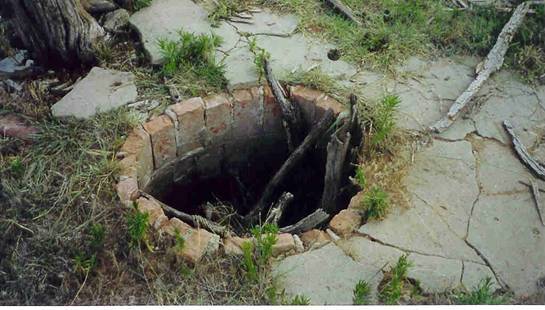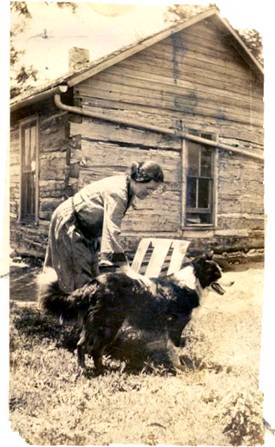|
Moderated by NW Okie! |
Volume 8 , Issue 52006Weekly eZine: (366 subscribers)Subscribe | Unsubscribe Using Desktop... |
Anatomy of A Cistern...

by - Charlie Cook in Louisiana Bayou Country
"My grandparents, Earl and Edith Smith Cook farmed in Grant Co., Oklahoma most of their adult life. They lived about three miles northwest of Lamont. While their farming equipment was fairly modern, they were never able to find a decent water well on that place. Therefore they had to have a cistern. It was located on their back porch, and had a crank type pump. That actually consisted of a chain of little 'buckets' that went round and round, dumping their little amount of water to run out of the spout.
During droughts, they had to haul water from neighborhood wells. Obviously they would ration the water during those times. I can remember hired hands bathing in the cows water tank.
The Cooks retired to Blackwell, Kay County, Oklahoma about 1950. The REA never reached their farm and so they never had electricity until after they retired. Baths were taken in a galvanized tub on the back porch. I can still remember the way a house smells when lighting is furnished by oil lamps not bad, just different and distinctive. There was no bathroom or running water in the kitchen. In the latter, there was the enamel water bucket, with the required dipper, which was communal. My Mom wasn't too wild about that.
Of course, the cistern water was supplied by rain running off the roof (wooden shingles in this case) and into metal gutters. The single central down spout emptied into a filter box. Hopefully, that removed much of the dirt, bugs, and bird poop the water picked up on its travel down the roof. Tin roofs would have been a little cleaner, but not much. The water out of the cistern tasted great, as I recall. I don't want to think why. It had a slightly brown tint.
About twenty years ago I visited that farm. The house was abandoned and windowless, but it and the out buildings were still standing, all much smaller than I remembered as a youth. The milk separator room I remembered was little more than a closet. The cistern was gone. Someone had finally found a vein of water for a well. I was scrounging the countryside for old milk cans and fruit jars. In the dump behind the pond dam in the pasture, I found the chain of little water buckets from the old cistern. No one but me remembers any of that earlier day, but a couple of my older cousins. I can tell you they lived a hard but good life. The passing of the family farm, as it used to be, is a sad event.
Cisterns were underground to keep them from freezing in the winter, even in such moderate climates as Oklahoma. However, in the very Deep South the cisterns would not freeze and burst in the winter, so they were on top of the ground, round, and made of wood. In Louisiana where I live they were made of cypress. They were made by coopers, the same people who made wooden barrels. Because they were above ground they could be elevated and sometimes the homes they supported had piping run from the cistern into the house - running water. The above ground cisterns had a space between the top of the sides and lid, so it could overflow. That space was usually covered with wire screen to keep the mosquitoes from laying eggs in the water - Yuk! Wiggle tails! Boy howdy. Do we taken modern conveniences for granted.
On the other hand, the soft rain water was wonderful for washing and bathing, particularly for hair and clothes. Sometimes well water was high in mineral content and called hard water. This sometimes affected its taste. Rain water is always sweet.
Today, an old filled cistern is a great place to find old bottles, as are filled wells and out house sites. This is particularly true in urban areas, since they had less space to use for dumping purposes. Over the years, I've excavated many of both. My poor old back won't allow much of that anymore.
 I'm inserting a photo of the house in the early days, showing Joseph's sister, Hannah Barnett Foster, who resided in Reno County, Kansas, while visiting her brother. It shows the gutters and down spout running across the house to join the one on the other side before draining into the cistern. I am also adding a photo taken a couple of years ago at the former site of the house, showing the now open round brick cistern. It was about four or five feet in diameter.
I'm inserting a photo of the house in the early days, showing Joseph's sister, Hannah Barnett Foster, who resided in Reno County, Kansas, while visiting her brother. It shows the gutters and down spout running across the house to join the one on the other side before draining into the cistern. I am also adding a photo taken a couple of years ago at the former site of the house, showing the now open round brick cistern. It was about four or five feet in diameter.
As I've mentioned in the web site before, the Waynoka, Woods Co., Oklahoma Historical Society is presently reassembling the log cabin my gg-grandfather, Joseph Barnett, built on the south bank of the Cimarron River, present Major County. It was built prior to Oklahoma statehood when that was still part of Woods County. He built it with cedar longs pulled out of the river with horses. This house had a brick lined cistern.
Note how the logs are dove tailed at the corners. That was all done by hand.
Incidentally, the Waynoka Historical Society still needs more funds to finish the log cabin project. Preserving history isn't cheap and Waynoka is a small community. They need help. Donations can be sent to the address below.
Waynoka Historical Society
P.O. Box 193
Waynoka, Ok 73860."
| View or Add Comments (0 Comments)
| Receive
updates ( subscribers) |
Unsubscribe
| © . Linda Mcgill Wagner - began © 1999 Contact Me | |
